Australian Colloid and Interface Symposium 2005 Special Issue
Patrick G. Hartley A B and Gregory G. Warr CA Conference Chair, Australian Colloid & Interface Symposium 2005, and Chair, Colloid & Surface Science Division, Royal Australian Chemical Institute.
B CSIRO Molecular & Health Technologies, Clayton South VIC 3169, Australia. Email: patrick.hartley@csiro.au
C School of Chemistry, University of Sydney, Sydney 2006, Australia. Email: g.warr@usyd.edu.au

Patrick Hartley is the project leader of the nanostructured materials group, within the CSIRO’s division of Molecular & Health Technologies. His group focusses on the development and characterization of functional materials for energy and biotechnology related applications, based on the manipulation of colloidal and interfacial properties. |

Greg Warr is a professor of chemistry at the University of Sydney, where he has been since 1988. His research centres around amphiphilic self-assembly in bulk and at interfaces, and complex fluid structure and dynamics, with particular interest in neutron beam techniques and AFM. He is currently on the Editorial Advisory Board for the Australian Journal of Chemistry. |
Australian Journal of Chemistry 58(9) 625-626 https://doi.org/10.1071/CH05248
Submitted: 6 September 2005 Accepted: 6 September 2005 Published: 21 September 2005
This special issue of the Australian Journal of Chemistry comprises a selection of papers from the program of the Australian Colloid and Interface Symposium (ACIS), which was held in Coogee Beach, Sydney (Fig. 1), in mid-February 2005.
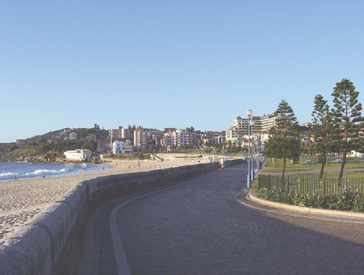
|
The ACIS 2005 program highlighted current research in colloid and interface science from both fundamental and technological viewpoints, as well as discussing some of the exciting new science areas in which the discipline is having an impact (Fig. 2). This year’s themes of Functional Interfaces & Advanced Coatings (chaired by John Ralston, Ian Wark Research Institute, and Simon Edwards, bStrategic) and Nanobiotechnology and Biointerfaces (Frank Caruso, University of Melbourne, and Hans Griesser, Ian Wark Research Institute) showcased recent advances in the design and study of ‘fit for function’ materials through careful control of interfacial properties. Scattering in Colloidal Systems (John White, ANU, and Michael James, ANSTO), meanwhile, drew attention to the opportunities for studying colloidal and interfacial properties using neutron and X-ray techniques. This is of particular current relevance given the imminent commissioning of Australia’s Synchrotron (www.synchrotron.vic.gov.au) and Replacement Reactor (www.ansto.gov.au/opal) facilities.
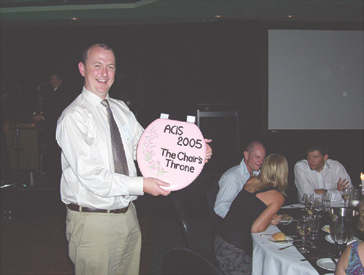
|
The particular importance of colloid and interface science to the food, minerals, and water industries was underscored by our technology-focussed themes: Food Science (Ian McKinnon, Monash University, and Maryann Augustin, Food Science Australia) and Solid–Liquid Separations (Peter Scales, University of Melbourne, and Phil Fawell, AJ Parker CRC). The Emerging Science theme (Patrick Hartley, CSIRO Molecular and Health Technologies, and George Franks, University of Newcastle), emphasized the study and manipulation of ‘soft’ interfaces, offering an excellent overview of the progress being made in this area.
The symposium is also the home of the A. E. Alexander lecture. This lecture commemorates the contributions made by A. E. Alexander (Professor of Physical Chemistry, University of Sydney 1956–1970) to colloid science, and in particular to the development of the discipline in Australia. The 2005 A. E. Alexander Lecturer was John Ralston of the Ian Wark Research Institute, University of South Australia (Table 1). His presentation ‘Solid–Liquid Interactions and Functional Surface Wettability’, is the basis of the review paper in this special issue.[1]
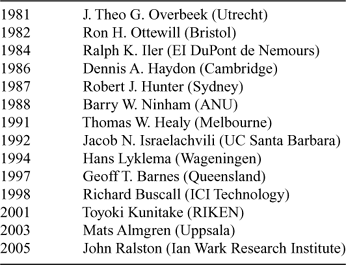
|
In assembling this special issue of the Australian Journal of Chemistry, we have attempted to offer a small taste of the ACIS 2005 symposium program. Two- and three-dimensional self-assembly processes are the focus of papers by Holt et al.,[2] Fong et al.,[3] and Böcking et al.[4] In addition, Edler reviews the current high level of activity in the generation of new materials using surfactant self-assembly and templating approaches.[5] Three-phase systems (solid–liquid–cavity or solid–liquid–liquid) are discussed in papers by Simovic et al.,[6] Okitsu et al.,[7] and Spicer et al.[8] This latter study of ‘crystal comets’, which result from the subtle interplay between crystallization and de-wetting processes, is depicted on the front cover of this issue.
Here and elsewhere dynamical effects emerged as an important growth area. At the molecular scale, Colegate and Bain describe the dynamics of nonionic surfactants in liquid jets in their paper.[9] On the nanoscale, Heim et al.[10] report a novel scanning probe microscopy study of the forces in the deformation and compaction of porous silica microspheres.
In closing, we would like to thank our colleagues on the symposium organizing committee, the theme chairs, and our kind sponsors for making ACIS 2005 both an enjoyable and informative meeting. We also thank Alison Green and colleagues for their work in putting together this special issue. The increased attendance at ACIS 2005 relative to 2003, plus a large international presence, are all encouraging signs for the future (Figs 3 and 4).
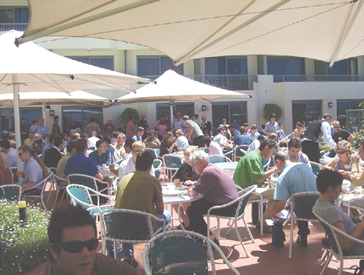
|
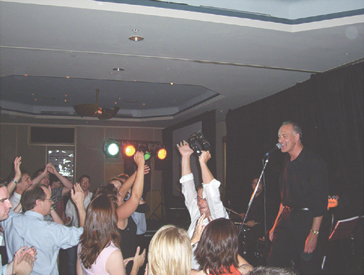
|
We also wish to draw your attention to the new website of the colloid and surface science division of the RACI: www.colloid-oz.org.au. Here you will find information concerning upcoming meetings, as well as historical resources and useful links. We encourage all readers of the Australian Journal of Chemistry to browse the site, and look forward to seeing you at ACIS 2007.
Patrick Hartley and Greg Warr
[1]
J. Ralston,
Aust. J. Chem. 2005, 58, 644.
| Crossref | GoogleScholarGoogle Scholar |
| Crossref | GoogleScholarGoogle Scholar |
| Crossref | GoogleScholarGoogle Scholar |
| Crossref | GoogleScholarGoogle Scholar |
| Crossref | GoogleScholarGoogle Scholar |
| Crossref | GoogleScholarGoogle Scholar |
| Crossref | GoogleScholarGoogle Scholar |
| Crossref | GoogleScholarGoogle Scholar |
| Crossref | GoogleScholarGoogle Scholar |
| Crossref | GoogleScholarGoogle Scholar |



